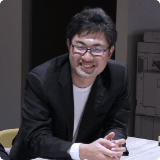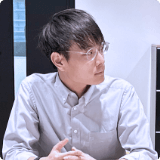

Roundtable discussion with the project members shaping the future of construction machinery.
To develop its first medium-sized hydraulic excavator equipped with a hydrogen fuel cell, Komatsu assembled a team of employees from all over Japan.
Project members share their thoughts, passions, and experiences of the time together developing the proof-of-concept machine.

Nakayama
| Construction machinery testing engineer | |
| Project role : Testing of the completed concept vehicle | |
| Joined Komatsu in 2015 |

Mitsuhoshi
| Construction machinery testing engineer | |
| Project role : Testing of the completed concept vehicle | |
| Joined Komatsu in 2015 |

Watanabe
| Electric vehicle development and design engineer | |
| Project role : Control software design | |
| Joined Komatsu in 2018 |

Nakagawa
| Hydraulic excavator development and design engineer | |
| Project role : Concept, 3D model production, strength/performance analysis, testing | |
| Joined Komatsu in 2018 |

First please tell us a little about this project.
“We normally test our hydraulic excavators at the testing facility at the plant assigned to its development. This time, we had to do everything from scratch, including the building of the testing facility. And since we could not use diesel fuel, we first had to figure out how to bring hydrogen to the site.
It really was a united effort of our team members and everyone at the plant. We all shared a huge sense of accomplishment.”
“It was also unique how Komatsu brought our project members from all over the country. It was coordinated on a business trip basis. We came together at the same time, in the same place, and got right to work. During those long hours when we worked so closely, we became good friends.”
“The four of us met and worked together very intensively over a very short period. I was amazed at how rapidly the project progressed.”
“Relatively few employees were assigned to this project. In fact, below the managers, we four were the only project staffers, and we are all around 30 years old. Komatsu has a corporate culture that encourages young people to take on challenges.”

Manager Hamaguchi (center) and the four members from across Japan who came together for this project.

How did you incorporate them in this project?
“From the start, I knew that I was part of something important. Hydrogen fuel cell technology is one way to achieve carbon neutrality so the development of this proof-of-concept machine was quite meaningful. At the same time, this was great opportunity to fully use and hone my technical expertise.”
“My usual work is considering optimal ways to equip the machine body with batteries and related devices. For this project, we had to study how to use hydrogen fuel cells to achieve carbon neutrality – a very different way to power construction equipment. We were on the frontlines of development, working in an environment where trial and error was encouraged. I was learning all about hydrogen fuel cells while designing the system.”
“Participation in the development of a proof-of-concept machine that uses hydrogen is a once-in-a-lifetime experience. That’s how I approached this project.”

Do you have some memorable episodes from the project?
“We were fortunate that the project assembled these talented team members and provided us with excellent leadership. Driving a project forward at speed with such a small team requires good communication. Of course, occasionally things didn't go as planned. When I needed help with the design, Watanabe-san was ready to lend his expertise. In the testing, we could rely on Mitsuhoshi-san and Nakayama-san.”
“The communication among the designers indeed was very smooth. When a problem with the working prototype came up, the people on the software side of development naturally had a lot to do; while tweaking the software, it is vital to monitor the hardware status as well. That demanded coordination and cooperation among all of us in many situations. At times like these, the designer Nakagawa-san and the testing staff were very proactive and resolved problems fairly quickly.”
“Until we got the concept machine to actually move, it was really tough. At first it didn't move at all. Watanabe-san took the lead in moving us forward with solutions.”
“In the final analysis, we all learned that trying to solve problems on your own is quite difficult. Take for example, the issue Mitsuhoshi-san mentioned. My first step was to get together with my colleagues and rapidly collect information. Based on my findings, I determined that there was no problem with the hardware and quickly narrowed the problem down to a part of the software. Looking back, I think the key is how quickly we can get to the cause of the problem. Thanks to everyone's cooperation, we were able to do that quickly.”
“Though our job titles may separate us into different disciplines like testing and design, the good relationships and mutual respect empowered us with the confidence to express views and ideas outside our own fields. With this overlapping support for our respective roles, the team moved the project forward.”

Mitsuhoshi performs examinations with a serious eye

Repeated trial and error brought us closer to perfection

Please tell us about your expectations for hydrogen fuel cell technology.
“When it comes to batteries, charging time is a constraint. Even if a customer’s work site wants to operate around the clock, it can only do so at full capacity during the day. At night, operations would be suspended for charging batteries. Hydrogen fuel cells eliminate charging time issues. They are not only carbon neutral, but also offer the added value of convenience.”

“This proof-of-concept machine gives us a clear vision of how the machine’s potential can be used in society.
Construction equipment is subjected to harsher and more intensive usage and conditions than passenger cars. Hydrogen tanks, piping, and other system component endure shocks and extensive vibration that we need to address.
Another facet to consider is the hydrogen fuel itself such as the method for refilling the tank and the price of hydrogen.
Some of these factors will be determined by market conditions and external conditions, but if we can overcome them, I think the future of construction equipment fueled by hydrogen will be bright!”
“When using fuel cells, I believe the key will be how we design the combination of fuel cells and other components to most efficiently use energy. By providing future development with feedback based on the data obtained from this prototype machine, we will be able to improve the design of future software.”
“There are quite a lot of people who have heard of fuel cells, but don't know what they actually are. I was like that before I joined the project. Since then, I have learned a lot.
“I think we will see the emergence of other new energy possibilities in the years ahead, and I hope people from other Komatsu centers and plants will have the opportunity to come together and collaborate on projects just as we did.”

Having completed development of the proof-of-concept machine, what is your next dream to realize at Komatsu?
“With the goal of achieving carbon neutrality, Komatsu is exploring a variety of technologies in its manufacture of construction machinery. I believe that our strengths in technology are what sets Komatsu apart. By consolidating our diverse technologies and by working together to incorporates Komatsu's electrification technology, I am confident that we can maximize our contribution to achievement of carbon neutrality. For Komatsu, this is absolutely possible.”
“The plant where I work is the most advanced in the electrification of products within Komatsu. As the development of hydrogen and other new energy sources advances, I have no doubt that hit products will emerge from the expanding selection of diverse options.”
“Society is changing at an incredible pace. I believe that there are other companies in Japan and overseas that have advanced even further toward carbon neutrality. We pursued this project in collaboration with Komatsu's overseas engineers and partner companies. Some of the people have already looked deeply into the background of the development scene and have perceived things that Komatsu alone cannot see. Collaborating with such people will be essential for us going forward. By leveraging our originally developed technology and allying our efforts with external partners to create innovative products, I believe that Komatsu can create remarkable value. I'm really looking forward to what the future holds for hydrogen fuel cells.”



Development of a medium-sized hydraulic excavator equipped with a hydrogen fuel-cell
